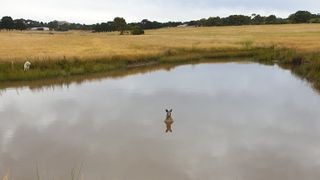Are you curious about the relationship between kangaroos and dogs? Why do kangaroos sometimes exhibit aggressive behavior towards dogs, even attempting to drown them? At WHY.EDU.VN, we delve into this intriguing question, providing clear explanations and expert insights into animal behavior and wildlife interactions. Discover the reasons behind this surprising behavior and learn how to keep your pets safe. Explore similar topics and find answers to all your burning questions at WHY.EDU.VN, your go-to resource for in-depth knowledge and understanding.
1. Introduction: The Surprising Conflict Between Kangaroos and Dogs
The interactions between kangaroos and dogs have captured public attention due to several reported incidents of kangaroos attempting to drown dogs. This behavior, while seemingly aggressive, is rooted in the natural instincts and survival strategies of kangaroos. Understanding the reasons behind these encounters can help dog owners and wildlife enthusiasts better appreciate the complexities of animal behavior. This article explores the factors that contribute to kangaroos drowning dogs, offering insights into their defensive mechanisms and the ecological context of these interactions.
2. Understanding Kangaroo Behavior: Defensive Mechanisms
2.1. Kangaroos as Prey Animals
Kangaroos are primarily herbivorous marsupials, meaning their diet consists mainly of plants. As prey animals, they have evolved several defense mechanisms to protect themselves from predators. These mechanisms include:
- Powerful Legs: Kangaroos possess strong hind legs that enable them to hop at high speeds, allowing them to quickly escape from danger.
- Sharp Claws: Their forelimbs have sharp claws that can be used for defense.
- Aggressive Posture: When threatened, kangaroos can adopt an aggressive posture, standing tall and using their forelimbs to box or kick.
2.2. The Role of Water in Kangaroo Defense
Water plays a crucial role in the defensive strategies of kangaroos. When pursued by predators, kangaroos often seek refuge in bodies of water, such as rivers, dams, or ponds. This behavior serves several purposes:
- Impeding Pursuit: Water can slow down or impede the pursuit of land-based predators.
- Providing a Defensive Advantage: In the water, kangaroos can use their strong legs and claws to defend themselves against attackers.
- Creating a Barrier: The water acts as a physical barrier, making it more difficult for predators to reach them.
 A kangaroo escaping into water.
A kangaroo escaping into water.
3. Why Dogs Trigger a Defensive Response
3.1. Dogs Resembling Dingoes
One of the primary reasons kangaroos exhibit aggressive behavior towards dogs is that dogs closely resemble dingoes, Australia’s native wild dogs. Dingoes have been a significant predator of kangaroos for thousands of years, and kangaroos have developed instinctive responses to their presence.
3.2. Evolutionary History: Dingoes as Predators
Dingoes (Canis dingo) are believed to have arrived in Australia between 5,000 and 8,500 years ago. Over time, they have become apex predators, preying on a variety of native animals, including kangaroos. Kangaroos have evolved to recognize dingoes as a threat and have developed defensive strategies to avoid becoming prey.
3.3. The Threat Perception: Dogs as Potential Predators
Even though domestic dogs are not typically predators of kangaroos, their physical resemblance to dingoes can trigger a defensive response. Kangaroos may perceive dogs as a potential threat and react aggressively to protect themselves. This is particularly true if the dog approaches the kangaroo closely or behaves in a way that the kangaroo interprets as threatening.
4. Instances of Kangaroos Drowning Dogs: Documented Cases
4.1. The Mick Moloney Incident
In October 2023, Mick Moloney encountered a kangaroo attempting to drown his dog, Hutchy, in the Murray River in Victoria, Australia. Moloney recounted how he saw the kangaroo standing waist-deep in the water, holding Hutchy submerged. He intervened, and after a brief struggle, managed to rescue his dog. The incident was captured on video and went viral, highlighting the potential danger dogs face in kangaroo habitats.
4.2. Brisbane River Incident (2020)
In 2020, another incident occurred in the Brisbane River in Queensland, where a kangaroo clashed with a small dog. Witnesses filmed the encounter, which began on land before both animals plunged into the water. The kangaroo appeared to be attempting to drown the dog before onlookers intervened.
4.3. New South Wales Incident (2014)
In 2014, a kangaroo in New South Wales tried to drown two staffies after the dogs cornered it in a dam. This incident further illustrates the defensive behavior of kangaroos when they feel threatened by dogs.
4.4. Analysis of Incident Patterns
These incidents share several common characteristics:
- Proximity to Water: The encounters typically occur near or in bodies of water.
- Perceived Threat: The kangaroos likely perceive the dogs as a threat, either due to their resemblance to dingoes or their behavior.
- Defensive Response: The kangaroos respond defensively, attempting to drown the dogs to neutralize the perceived threat.
5. Expert Opinions: Insights from Wildlife Ecologists
5.1. Euan Ritchie’s Perspective
Euan Ritchie, a professor of wildlife ecology and conservation at Deakin University in Australia, explains that kangaroos perceive dogs as a threat because of their close resemblance to dingoes. He notes that this behavior is a survival strategy kangaroos have developed over thousands of years to defend themselves against dingoes.
5.2. Graeme Coulson’s Perspective
Graeme Coulson, an honorary principal fellow at the University of Melbourne specializing in kangaroo behavior and ecology, adds that attempting to drown dogs is an instinctive behavior for kangaroos. Male kangaroos, in particular, are strong enough to stand up and handle a dog-paddling adversary in the water.
6. Factors Contributing to the Behavior
6.1. Environmental Stressors
Environmental stressors, such as habitat loss and drought, can exacerbate conflicts between kangaroos and dogs. When resources are scarce, kangaroos may become more defensive of their territory and react more aggressively to perceived threats.
6.2. Territoriality
Kangaroos are territorial animals, and they may defend their territory against intruders, including dogs. This is especially true during mating season when kangaroos are more protective of their resources and mates.
6.3. The Role of Instinct
The behavior of kangaroos attempting to drown dogs is largely instinctive. These instincts are deeply ingrained in their DNA and are triggered by specific cues, such as the presence of a dog in their vicinity.
7. Comparing Kangaroo and Dingo Behavior
7.1. Dingo Hunting Strategies
Dingoes typically hunt kangaroos in packs, using a strategy of relay chasing to exhaust their prey. They target the hind legs or neck of the kangaroo to bring it down.
7.2. Kangaroo Defense Strategies
Kangaroos have developed several defense strategies to counter dingo attacks, including:
- Seeking Refuge in Water: As discussed earlier, kangaroos often seek refuge in bodies of water to escape dingoes.
- Aggressive Defense: Kangaroos may stand their ground and use their claws and powerful legs to defend themselves.
- Mobbing: In some cases, groups of kangaroos may mob a dingo, attempting to drive it away.
7.3. Contrasting Behaviors
While dingoes are active hunters, kangaroos are primarily defensive. The behavior of kangaroos attempting to drown dogs is a defensive response triggered by the perception of a threat, rather than a predatory behavior.
8. Protecting Dogs: Practical Tips for Owners
8.1. Keeping Dogs on Leashes
One of the most effective ways to protect dogs in kangaroo habitats is to keep them on leashes. This prevents them from approaching kangaroos and triggering a defensive response.
8.2. Avoiding Kangaroo Habitats During Peak Activity
Kangaroos are most active during dawn and dusk. Dog owners should avoid kangaroo habitats during these times to minimize the risk of encounters.
8.3. Recognizing Signs of Kangaroo Aggression
It is important to recognize the signs of kangaroo aggression, such as:
- Standing Tall: Kangaroos may stand tall to appear larger and more intimidating.
- Stomping Feet: They may stomp their feet to warn off potential threats.
- Hissing or Growling: Kangaroos may hiss or growl to communicate their displeasure.
- Boxing: They may use their forelimbs to box or strike at a perceived threat.
8.4. What to Do in an Encounter
If you encounter a kangaroo with your dog, it is important to:
- Remain Calm: Avoid sudden movements or loud noises.
- Create Distance: Slowly back away from the kangaroo, keeping your dog close.
- Do Not Run: Running may trigger the kangaroo’s pursuit instinct.
- Seek Shelter: If possible, seek shelter behind a tree or in a building.
9. The Broader Ecological Context
9.1. Human Impact on Kangaroo-Dog Interactions
Human activities, such as habitat destruction and urbanization, have altered the natural environment and increased the likelihood of encounters between kangaroos and dogs. As kangaroo habitats shrink, they are more likely to come into contact with humans and their pets.
9.2. The Importance of Conservation
Conserving kangaroo habitats is essential for maintaining the balance of the ecosystem and reducing conflicts between kangaroos and dogs. Conservation efforts can help ensure that kangaroos have adequate space and resources, reducing the likelihood of defensive behaviors.
9.3. Coexistence Strategies
Promoting coexistence strategies is crucial for minimizing conflicts between humans, dogs, and kangaroos. These strategies include:
- Education: Educating the public about kangaroo behavior and how to avoid encounters.
- Responsible Pet Ownership: Encouraging responsible pet ownership, including keeping dogs on leashes and avoiding kangaroo habitats.
- Habitat Management: Implementing habitat management strategies to protect kangaroo habitats and reduce the risk of encounters.
10. Addressing Misconceptions About Kangaroos
10.1. Kangaroos as Naturally Aggressive Animals
It is a misconception that kangaroos are naturally aggressive animals. Kangaroos are typically docile and peaceful, but they will defend themselves if they feel threatened.
10.2. Differentiating Defensive and Predatory Behaviors
It is important to differentiate between defensive and predatory behaviors. The behavior of kangaroos attempting to drown dogs is a defensive response, not a predatory one.
10.3. Understanding the Context of Encounters
Understanding the context of encounters between kangaroos and dogs is essential for interpreting their behavior. Factors such as habitat, territoriality, and perceived threats all play a role in these interactions.
11. Legal Considerations
11.1. Protecting Native Wildlife
In Australia, kangaroos are protected under federal and state laws. It is illegal to harm or harass kangaroos, and penalties for doing so can be severe.
11.2. Responsible Dog Ownership
Dog owners have a legal responsibility to control their pets and prevent them from harming native wildlife. Failure to do so can result in fines or other penalties.
11.3. Reporting Incidents
Incidents involving kangaroos and dogs should be reported to local wildlife authorities. This helps authorities monitor kangaroo populations and address potential conflicts.
12. Future Research Directions
12.1. Studying Kangaroo-Dog Interactions
Further research is needed to better understand the dynamics of kangaroo-dog interactions. This research could focus on:
- Behavioral Studies: Investigating the specific behaviors that trigger defensive responses in kangaroos.
- Ecological Studies: Examining the impact of habitat loss and other environmental stressors on kangaroo-dog interactions.
- Mitigation Strategies: Developing effective strategies for mitigating conflicts between kangaroos and dogs.
12.2. Developing Non-Invasive Monitoring Techniques
Developing non-invasive monitoring techniques, such as camera trapping and GPS tracking, could help researchers track kangaroo and dog movements and identify areas where conflicts are most likely to occur.
12.3. Community Engagement
Engaging local communities in research and conservation efforts is essential for promoting coexistence and reducing conflicts between humans, dogs, and kangaroos.
13. Personal Accounts: Stories from the Field
13.1. Wildlife Rescuers’ Experiences
Wildlife rescuers often encounter kangaroos that have been injured or orphaned due to conflicts with dogs. These experiences highlight the importance of protecting kangaroos and promoting responsible pet ownership.
13.2. Dog Owners’ Perspectives
Dog owners who have experienced encounters with kangaroos can provide valuable insights into the challenges and rewards of living in kangaroo habitats. Their stories can help educate others and promote coexistence.
13.3. The Role of Local Communities
Local communities play a crucial role in protecting kangaroos and promoting coexistence. Their knowledge and involvement are essential for successful conservation efforts.
14. The Ethical Considerations
14.1. Balancing Human and Animal Interests
Balancing human and animal interests is a complex ethical challenge. It is important to consider the needs of both humans and animals when making decisions about land use and conservation.
14.2. Promoting Respect for Wildlife
Promoting respect for wildlife is essential for fostering a culture of coexistence. Education and outreach programs can help people appreciate the value of kangaroos and other native animals.
14.3. The Importance of Compassion
Compassion is a key element of ethical decision-making. We should strive to treat all living beings with kindness and respect, including kangaroos and dogs.
15. Innovative Solutions
15.1. Creating Wildlife Corridors
Creating wildlife corridors can help kangaroos move between fragmented habitats, reducing the likelihood of encounters with humans and dogs.
15.2. Implementing Exclusion Fencing
Implementing exclusion fencing can help keep dogs out of sensitive kangaroo habitats, protecting both kangaroos and dogs.
15.3. Developing Early Warning Systems
Developing early warning systems, such as GPS tracking devices that alert dog owners when they are approaching kangaroo habitats, could help prevent encounters.
16. Conclusion: Fostering Coexistence
16.1. Emphasizing the Need for Understanding
Understanding the behavior of kangaroos and the factors that contribute to their interactions with dogs is essential for fostering coexistence.
16.2. Promoting Responsible Pet Ownership
Promoting responsible pet ownership, including keeping dogs on leashes and avoiding kangaroo habitats, is crucial for protecting both kangaroos and dogs.
16.3. Encouraging Community Involvement
Encouraging community involvement in conservation efforts can help ensure that kangaroos and dogs can coexist peacefully in shared environments.
By understanding the reasons why kangaroos sometimes drown dogs, we can take steps to protect both species and promote a more harmonious coexistence. Through education, responsible pet ownership, and conservation efforts, we can help ensure that kangaroos and dogs can share the Australian landscape for generations to come.
17. Call to Action: Explore WHY.EDU.VN for More Answers
Have more questions about animal behavior or other intriguing topics? Visit WHY.EDU.VN at 101 Curiosity Lane, Answer Town, CA 90210, United States. Reach out to us via Whatsapp at +1 (213) 555-0101. At WHY.EDU.VN, we provide detailed, expert-backed answers to all your questions. Our platform connects you with specialists who can offer insights into a wide range of subjects, from wildlife interactions to scientific phenomena. Don’t stay curious – find your answers today at WHY.EDU.VN!
18. FAQ: Frequently Asked Questions
18.1. Why do kangaroos go into water?
Kangaroos seek refuge in water to escape predators like dingoes and dogs, which are less effective in aquatic environments.
18.2. Are kangaroos aggressive to humans?
Kangaroos are not typically aggressive to humans unless they feel threatened or are protecting their young.
18.3. How can I protect my dog from kangaroos?
Keep your dog on a leash, avoid kangaroo habitats during peak activity times (dawn and dusk), and recognize signs of kangaroo aggression.
18.4. What should I do if a kangaroo approaches my dog?
Remain calm, create distance by slowly backing away, and avoid running, which may trigger the kangaroo’s pursuit instinct.
18.5. Are kangaroos protected by law?
Yes, in Australia, kangaroos are protected under federal and state laws, making it illegal to harm or harass them.
18.6. Do all kangaroos drown dogs?
No, not all kangaroos attempt to drown dogs. This behavior is typically a defensive response triggered by a perceived threat.
18.7. What is the role of dingoes in kangaroo behavior?
Dingoes are natural predators of kangaroos, and kangaroos have evolved to recognize and defend themselves against dingoes.
18.8. How does habitat loss affect kangaroo-dog interactions?
Habitat loss forces kangaroos and dogs into closer proximity, increasing the likelihood of encounters and potential conflicts.
18.9. Can kangaroos and dogs coexist peacefully?
Yes, kangaroos and dogs can coexist peacefully with responsible pet ownership, education, and conservation efforts.
18.10. Where can I learn more about kangaroo behavior?
Visit why.edu.vn for more in-depth information and expert insights on kangaroo behavior and wildlife interactions.

